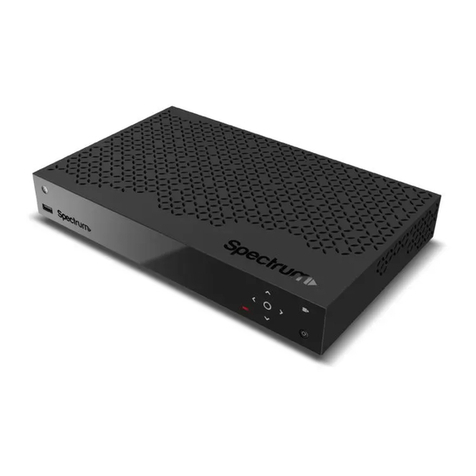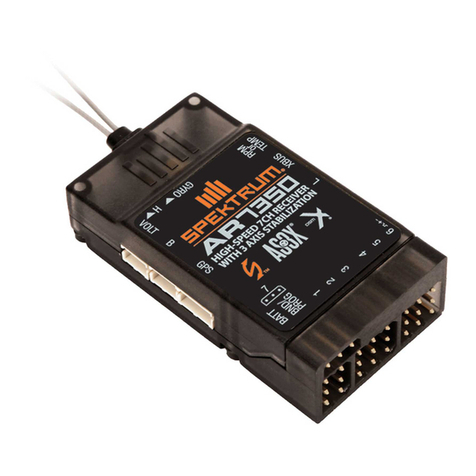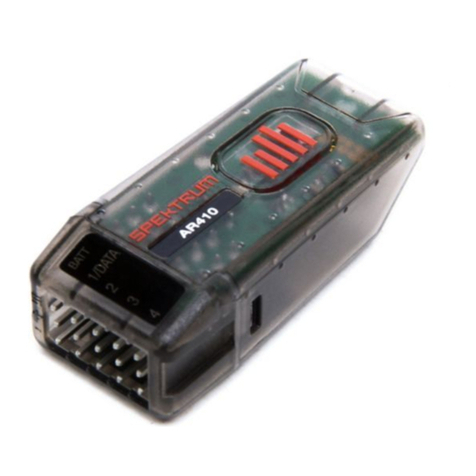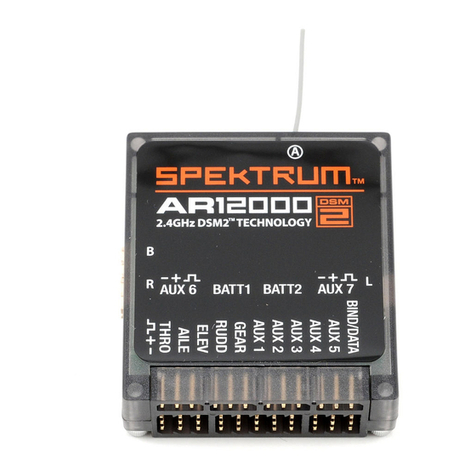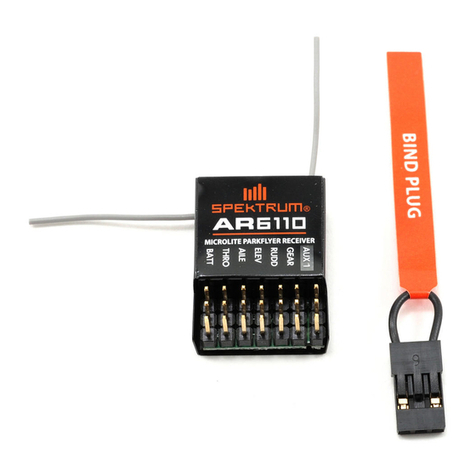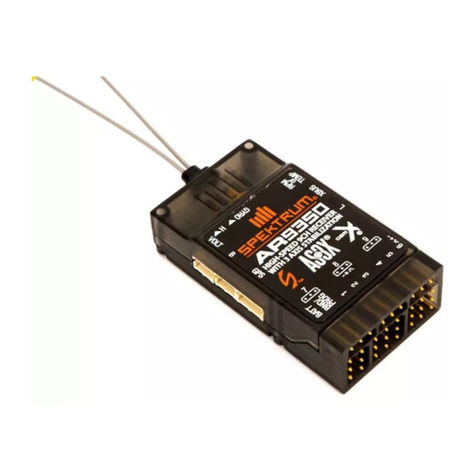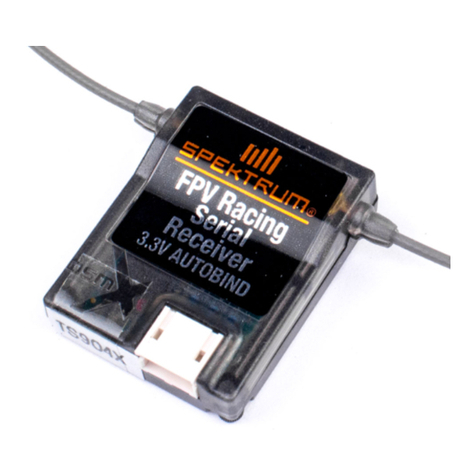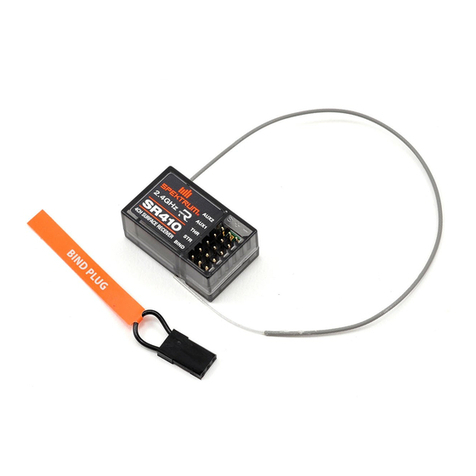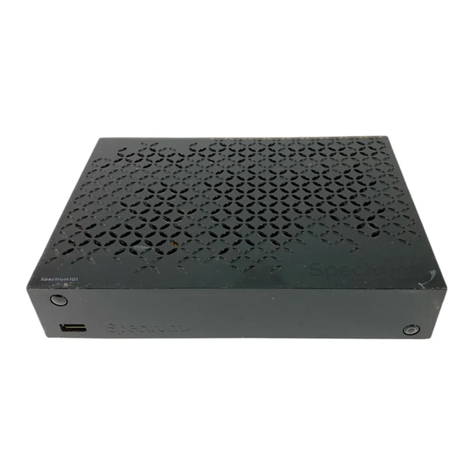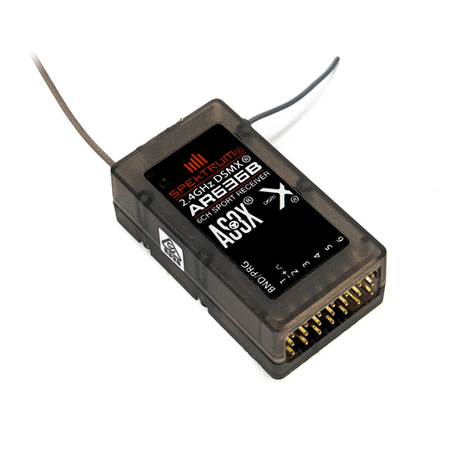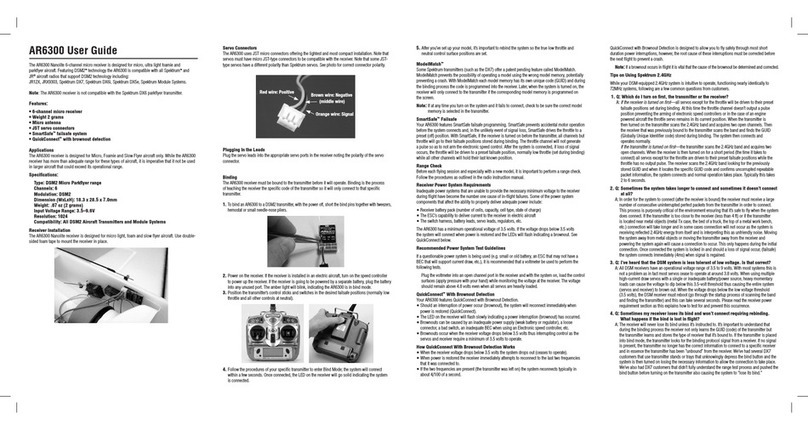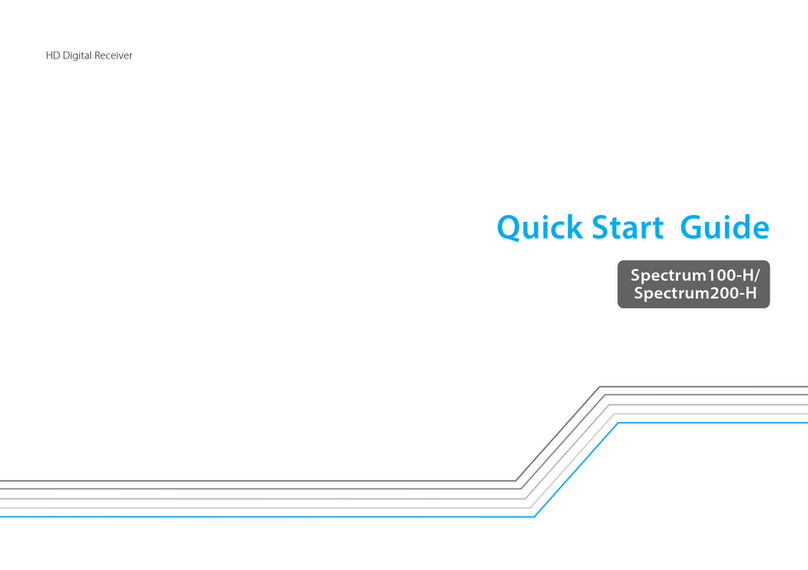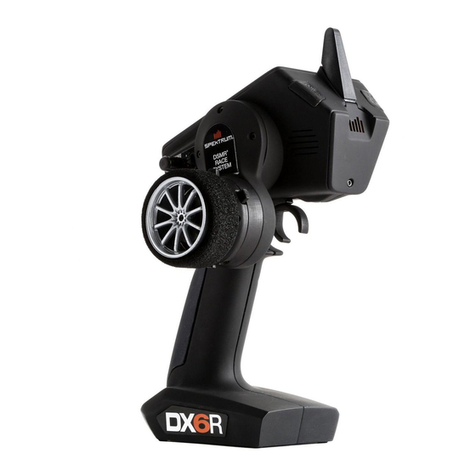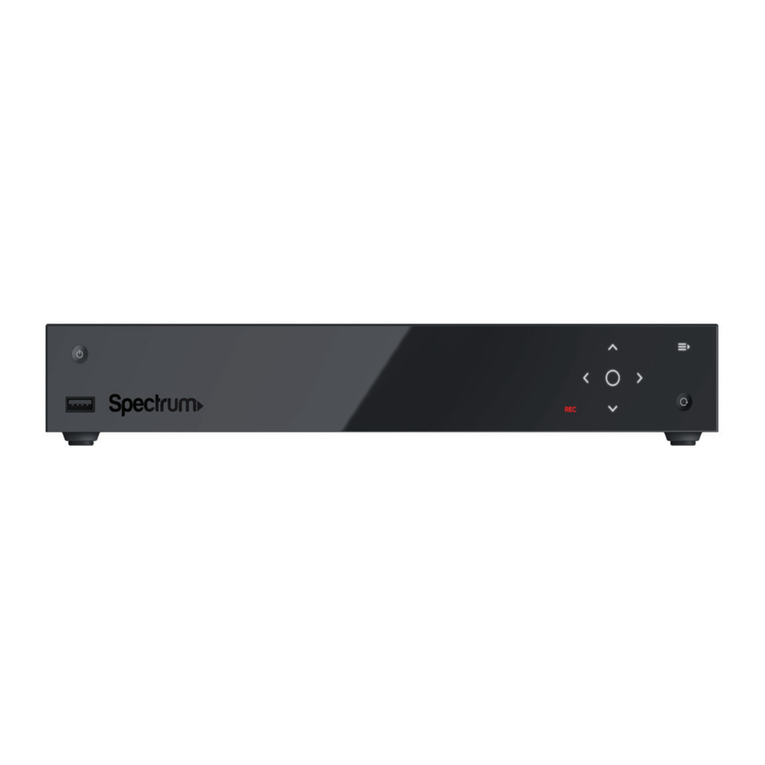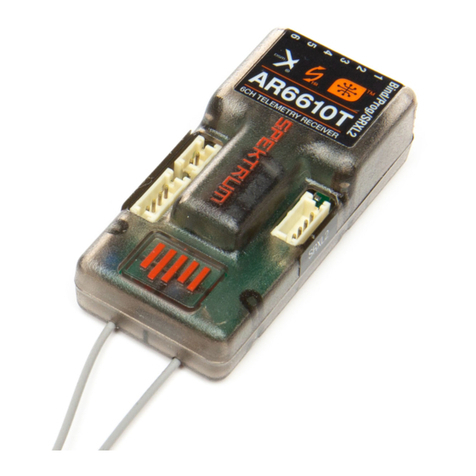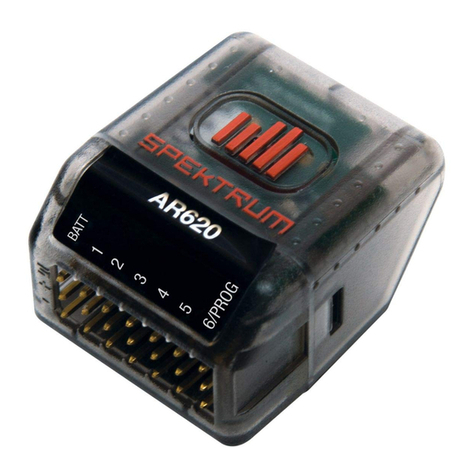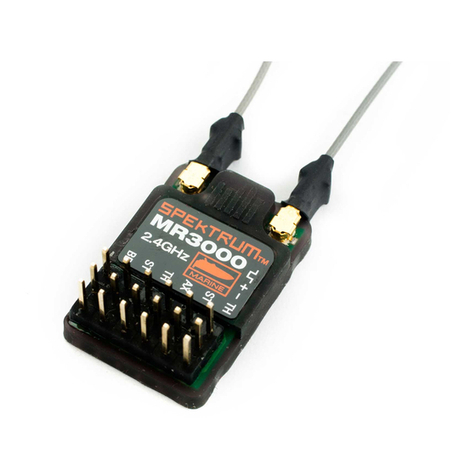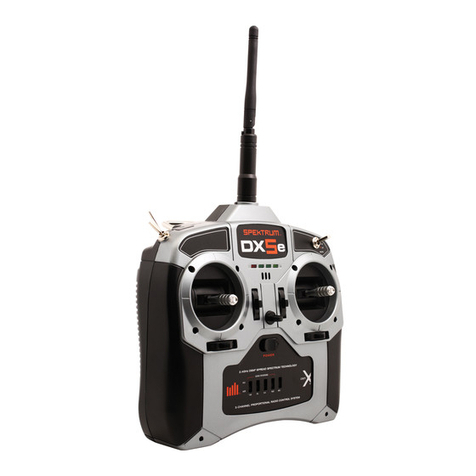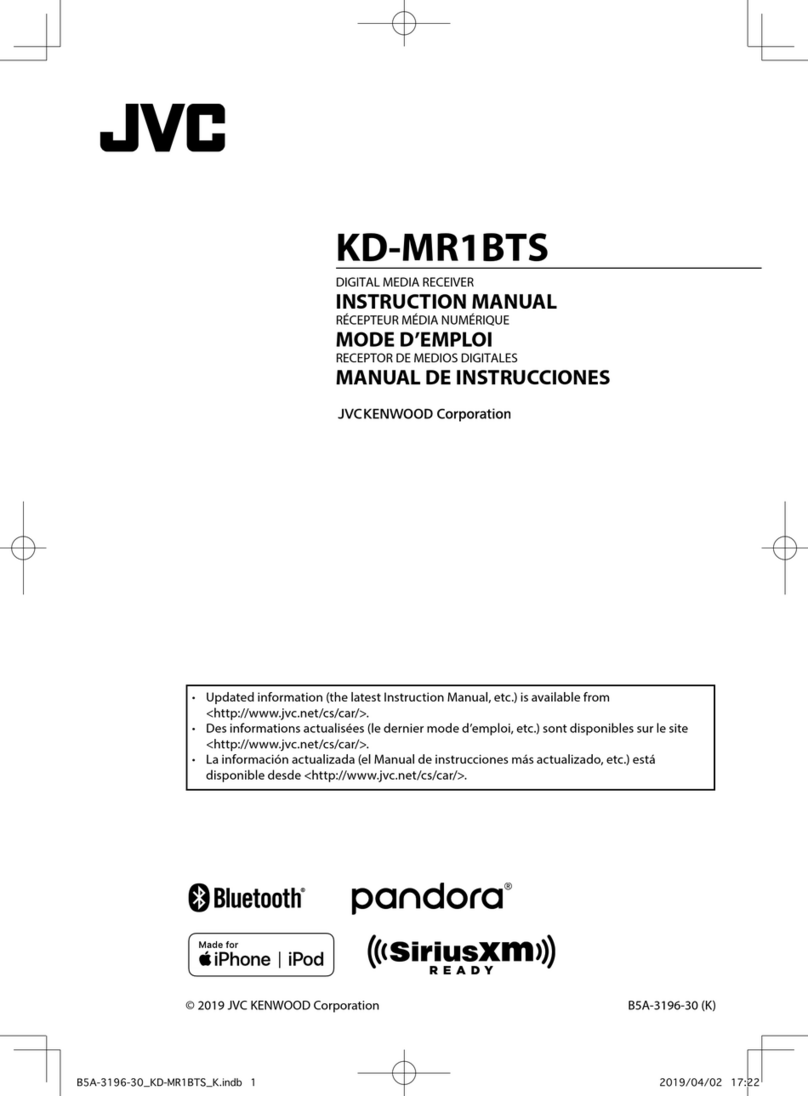Transmitter Specific Binding Instructions
DX5e:
1. To bind your AR6400 to the DX5e, plug the battery into the receiver. The LED on the
receiver will begin flashing.
2. Move the sticks and switches on the transmitter to the desired failsafe positions (low
throttle and neutral control positions).
3. Pull and hold the Trainer Switch on the transmitter while turning the transmitter on.
Release the trainer switch once the LEDs on the front of the transmitter flash.
4. The LED on the receiver will go solid and the system will connect after several seconds.
DX6i:
1. To bind your AR6400 to the DX6i, plug the battery into the receiver. The LED on the
receiver will begin flashing.
2. Move the sticks and switches on the transmitter to the desired failsafe positions (low
throttle and neutral control positions).
3. Pull and hold the Trainer Switch on the transmitter while turning the transmitter on.
Release the trainer switch once the word BIND flashes on the LCD screen on the front of
the transmitter.
4. The LED on the receiver will go solid and the system will connect after several seconds.
DX7 (includes DX7se):
1. To bind your AR6400 to the DX7, plug the battery into the receiver. The LED on the receiver
will begin flashing.
2. Move the sticks and switches on the transmitter to the desired failsafe positions (low
throttle and neutral control positions).
3. Press the bind button on the back of the transmitter while turning the transmitter on.
The bind button on the back of the transmitter will flash.
Release the button after 2-3 seconds.
4. The LED on the receiver will go solid and the system will connect after several seconds.
Warranty Period
Exclusive Warranty- Horizon Hobby, Inc., (Horizon) warranties that the Products purchased (the “Product”)
will be free from defects in materials and workmanship for a period of 1 year from the date of purchase by the
Purchaser.
Limited Warranty
(a) This warranty is limited to the original Purchaser (“Purchaser”) and is not transferable. REPAIR OR
REPLACEMENT AS PROVIDED UNDER THIS WARRANTY IS THE EXCLUSIVE REMEDY OF THE PURCHASER.
This warranty covers only those Products purchased from an authorized Horizon dealer. Third party transactions
are not covered by this warranty. Proof of purchase is required for warranty claims. Further, Horizon reserves
the right to change or modify this warranty without notice and disclaims all other warranties, express or
implied.
(b) Limitations- HORIZON MAKES NO WARRANTY OR REPRESENTATION, EXPRESS OR IMPLIED, ABOUT
NON-INFRINGEMENT, MERCHANTABILITY OR FITNESS FOR A PARTICULAR PURPOSE OF THE PRODUCT.
THE PURCHASER ACKNOWLEDGES THAT THEY ALONE HAVE DETERMINED THAT THE PRODUCT WILL
SUITABLY MEET THE REQUIREMENTS OF THE PURCHASER’S INTENDED USE.
(c) Purchaser Remedy- Horizon’s sole obligation hereunder shall be that Horizon will, at its option, (i) repair
or (ii) replace, any Product determined by Horizon to be defective. In the event of a defect, these are the
Purchaser’s exclusive remedies. Horizon reserves the right to inspect any and all equipment involved in a
warranty claim. Repair or replacement decisions are at the sole discretion of Horizon. This warranty does not
cover cosmetic damage or damage due to acts of God, accident, misuse, abuse, negligence, commercial use, or
modification of or to any part of the Product. This warranty does not cover damage due to improper installation,
operation, maintenance, or attempted repair by anyone other than Horizon. Return of any goods by Purchaser
must be approved in writing by Horizon before shipment.
Damage Limits
HORIZON SHALL NOT BE LIABLE FOR SPECIAL, INDIRECT OR CONSEQUENTIAL DAMAGES, LOSS OF
PROFITS OR PRODUCTION OR COMMERCIAL LOSS IN ANY WAY CONNECTED WITH THE PRODUCT,
WHETHER SUCH CLAIM IS BASED IN CONTRACT, WARRANTY, NEGLIGENCE, OR STRICT LIABILITY. Further,
in no event shall the liability of Horizon exceed the individual price of the Product on which liability is asserted.
As Horizon has no control over use, setup, final assembly, modification or misuse, no liability shall be assumed
nor accepted for any resulting damage or injury. By the act of use, setup or assembly, the user accepts all
resulting liability.
If you as the Purchaser or user are not prepared to accept the liability associated with the use of this Product,
you are advised to return this Product immediately in new and unused condition to the place of purchase.
Law: These Terms are governed by Illinois law (without regard to conflict of law principals).
Safety Precautions
This is a sophisticated hobby Product and not a toy. It must be operated with caution and common sense
and requires some basic mechanical ability. Failure to operate this Product in a safe and responsible manner
could result in injury or damage to the Product or other property. This Product is not intended for use by
children without direct adult supervision. The Product manual contains instructions for safety, operation
and maintenance. It is essential to read and follow all the instructions and warnings in the manual, prior to
assembly, setup or use, in order to operate correctly and avoid damage or injury.
Questions, Assistance, and Repairs
Your local hobby store and/or place of purchase cannot provide warranty support or repair. Once assembly,
setup or use of the Product has been started, you must contact Horizon directly. This will enable Horizon to
better answer your questions and service you in the event that you may need any assistance. For questions or
assistance,
please
direct
your
email
to
[email protected],
or
call
877.504.0233
toll
free
to
speak to the Product Support department.
Inspection or Repairs
If this Product needs to be inspected or repaired, please call for a Return Merchandise Authorization (RMA).
Pack the Product securely using a shipping carton. Please note that original boxes may be included, but are
not designed to withstand the rigors of shipping without additional protection. Ship via a carrier that provides
tracking and insurance for lost or damaged parcels, as Horizon is not responsible for merchandise until it
arrives and is accepted at our facility. A Service Repair Request is available at www.horizonhobby.com on
the “Support” tab. If you do not have internet access, please include a letter with your complete name, street
address, email address and phone number where you can be reached during business days, your RMA number,
a list of the included items, method of payment for any non-warranty expenses and a brief summary of the
problem. Your original sales receipt must also be included for warranty consideration. Be sure your name,
address, and RMA number are clearly written on the outside of the shipping carton.
Warranty Inspection and Repairs
To receive warranty service, you must include your original sales receipt verifying the proof-of-purchase date.
Provided warranty conditions have been met, your Product will be repaired or replaced free of charge. Repair or
replacement decisions are at the sole discretion of Horizon Hobby.
Non-Warranty Repairs
Should your repair not be covered by warranty the repair will be completed and payment will be required
without notification or estimate of the expense unless the expense exceeds 50% of the retail purchase cost. By
submitting the item for repair you are agreeing to payment of the repair without notification. Repair estimates
are available upon request. You must include this request with your repair. Non-warranty repair estimates will
be billed a minimum of ½ hour of labor. In addition you will be billed for return freight. Please advise us of your
preferred method of payment. Horizon accepts money orders and cashiers checks, as well as Visa, MasterCard,
American Express, and Discover cards. If you choose to pay by credit card, please include your credit card
number and expiration date. Any repair left unpaid or unclaimed after 90 days will be considered abandoned
and will be disposed of accordingly. Please note: non-warranty repair is only available on electronics and
model engines.
Electronics and engines requiring inspection or repair should be shipped to the following address:
Horizon Service Center
4105 Fieldstone Road
Champaign, Illinois 61822 USA
All other Products requiring warranty inspection or repair should be shipped to the following address:
Horizon Product Support
4105 Fieldstone Road
Champaign, Illinois 61822 USA
Please
call
877-504-0233
or
e-mail
us
at
[email protected] with
any
questions
or
concerns
regarding this product or warranty.
European Union:
Electronics and engines requiring inspection or repair should be shipped to one of the following addresses:
FCC Information
This device complies with part 15 of the FCC rules. Operation is subject to the following two
conditions: (1) This device may not cause harmful interference, and (2) this device must accept any
interference received, including interference that may cause undesired operation.
Caution: Changes or modifications not expressly approved by the party responsible for
compliance could void the user’s authority to operate the equipment.
This product contains a radio transmitter with wireless technology which has been tested and found to be
compliant with the applicable regulations governing a radio transmitter in the 2.400GHz to 2.4835GHz
frequency range.
Horizon Hobby UK
Units 1-4 Ployters Rd
Staple Tye, Harlow
Essex CM18 7NS
United Kingdom
with any questions or concerns regarding this product or warranty.
Horizon Technischer Service
Hamburger Str. 10
25335 Elmshorn
Germany
with any questions or concerns regarding this product or warranty.
Revised 09/09 15322.2
CE Compliance Information for the European Union
Declaration of Conformity
(in accordance with ISO/IEC 17050-1)
No. HH2009040201
Product(s): AR6400 Receiver
Item Number(s): SPMAR6400
The object of declaration described above is in conformity with the requirements of the specifications
listed below, following the provisions of the European R&TTE directive 1999/5/EC:
EN 301 489-1, 301 489-17 General EMC requirements for Radio equipment
Signed for and on behalf of:
Horizon Hobby, Inc.
Champaign, IL USA
April 02, 2009
Steven A. Hall
Vice President
International Operations and Risk Management
Horizon Hobby, Inc.
Instructions for Disposal of WEEE by Users in the
European Union
This product must not be disposed of with other waste. Instead, it is the user’s responsibility to dispose
of their waste equipment by handing it over to a designated collection point for the recycling of waste
electrical and electronic equipment. The separate collection and recycling of your waste equipment at
the time of disposal will help to conserve natural resources and ensure that it is recycled in a manner
that protects human health and the environment. For more information about where you can drop off
your waste equipment for recycling, please contact your local city office, your household waste disposal
service or where you purchased the product.
Tips on Using Spektrum 2.4GHz
ModelMatch™
Some Spektrum and JR transmitters offer a patent pending feature called ModelMatch. ModelMatch
prevents the possibility of operating a model using the wrong model memory, potentially preventing a
crash. With ModelMatch each model memory has its own unique code (GUID) and during the binding
process the code is programmed into the receiver. Later, when the system is turned on, the receiver will
only connect to the transmitter if the corresponding model memory is programmed on screen.
Note: If at any time you turn on the system and it fails to connect, check to be sure the correct model
memory is selected in the transmitter. Please note that the DX5e and Aircraft Modules do not have
ModelMatch.
Failsafe
Your AR6400 features failsafe programming. Failsafe prevents accidental motor operation before the
system connects and, in the unlikely event of signal loss, Failsafe drives the throttle to a preset (off)
position and all other servos to their neutral positions.
While your DSM equipped 2.4GHz system is intuitive to operate, functioning nearly identically to 72MHz
systems, following are a few common questions from customers.
1. Q: Sometimes the system takes longer to connect and sometimes it doesn’t connect at
all?
A: In order for the system to connect (after the receiver is bound) the receiver must receive a large
number of consecutive uninterrupted perfect packets from the transmitter. This process is purposely
critical of the environment ensuring that it’s safe to fly when the system does connect. If the
transmitter is too close to the receiver (less than 4 ft) or if the transmitter is located near metal
objects (metal TX case, the bed of a truck, the top of a metal work bench, etc.) connection will take
longer and in some cases connection will not occur as the system is receiving reflected 2.4GHz
energy from itself and is interpreting this as unfriendly noise. Moving the system away from metal
objects or moving the transmitter away from the receiver and powering the system again will cause a
connection to occur. This only happens during the initial connection. Once connected the system is
locked-in and should a loss of signal occur (failsafe) the system connects immediately (4ms) when
signal is regained.
2. Q: Sometimes my receiver loses its bind and won’t connect requiring rebinding.
What happens if the bind is lost in ight?
A: The receiver will never lose its bind unless it’s instructed to. It’s important to understand that during
the binding process the receiver not only learns the GUID (code) of the transmitter but the transmitter
learns and stores the type of receiver that it’s bound to. If the transmitter is placed into bind mode,
the transmitter looks for the binding protocol signal from a receiver. If no signal is present, the
transmitter no longer has the correct information to connect to a specific receiver and in essence
the transmitter has been “unbound” from the receiver. We’ve had several DX7 customers that use
transmitter stands or trays that unknowingly depress the bind button and the system is then turned
on losing the necessary information to allow the connection to take place. We’ve also had DX7
customers that didn’t fully understand the range test process and pushed the bind button before
turning on the transmitter also causing the system to “lose its bind.”
© 2009 HorizonHobby, Inc. Spektrum and E-flite products aredistributed exclusivelyby
Horizon Hobby, Inc. 4105 Fieldstone Road, Champaign, IL 61822USA Call toll-free, 877-504-0233.
The Spektrum trademark is used with permission of Bachmann Industries, Inc.
Trouble Shooting Guide
Problem Possible Cause Solution
• User did not lower throttle trim and
throttle stick prior to initializing the
aircraft.
• Throttle channel is reversed.
Note: Futaba transmitters
(equipped with Spektrum modules)
may require you to reverse the
throttle channel.
• Is the Brushed/Brushless option
correctly selected for the power
system?
• User did not wait at least 5 seconds
after powering the transmitter prior
to connecting the flight battery to
the aircraft.
• User bound the aircraft to a different
transmitter.
• Transmitter was too close to
aircraft during the initialization
process.
• User did not initially set up their
transmitter prior to binding to the
aircraft.
• User may have accidentally plugged
the flight battery in the wrong
polarity.
• Lower throttle stick and
throttle trim to their lowest
settings.
• Reverse throttle channel
on specific transmitter if
applicable.
• Change to the correct
power system (brushed or
brushless).
• Unplug, then reconnect
flight battery.
• Rebind aircraft to your
desired compatible
transmitter.
• Move transmitter
(powered on) a few feet
from the aircraft prior to
reconnecting the flight
battery.
• See the “Advanced
Programming” section of
this manual.
• Replace AR6400 board
(SPMAR6400) and ensure
the RED polarity marks
are facing the same
direction when connecting
the flight battery to the
AR6400 board.
Aircraft will not “throttle up”
but all other controls seem
to function.
LED on aircraft remains
flashing and cannot be
controlled by transmitter.
Controls appear to be
reversed after binding to a
different transmitter.
Aircraft does not function
after connecting flight battery
and aircraft smells burnt.
